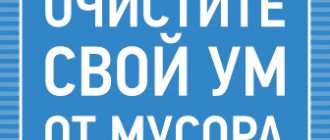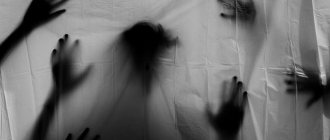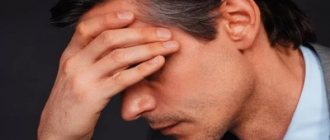The concept of “stress” has become very firmly established in everyday life in recent decades. The term itself refers to emotional dysfunction and tension, which is always accompanied by a negative mood. It came to us from medieval England, where “distress” meant grief or need.
Stress is the body’s ability to adapt to changing living conditions. In the modern rhythm of life, conditions change not only every day, but also every hour. Therefore, we can say with confidence that stressful situations have become commonplace.
By stress we mean a feeling of dissatisfaction, bitterness of loss or seasonal blues, but despite the general symptoms, this phenomenon has several types, subtypes, stages of development and phases. Let's take a closer look at them.
What is stress?
Stress is a tense state of the body that appears as a defensive reaction to the influence of various unfavorable factors. Many people, being stressed every day, do not even understand that this is an abnormal phenomenon that needs to be gotten rid of. Stress awaits a person everywhere: at home, at work, on public transport. When stressful situations are irregular, there is nothing to worry about. But when the state of stress lasts a long time and occurs frequently, it is called distress. Against this background, serious illnesses may develop.
Evening yoga for stress
If you like yoga, two simple poses will allow you to achieve complete relaxation and help you calm down after a busy day.
- Pose 1 . Sit on the floor with your legs crossed. Place your hands on your knees. Try to focus all your attention on the pose you have taken. The base of the spine should be as close to the floor as possible, and the head should be raised high. Imagine that your spine is stretching.
- Pose 2 . Lying on your back with your legs wide apart, place your hands, palms up, about 15 cm from your torso. Slowly rotate your limbs, first outward, then inward. Turn your head from side to side. Imagine that your legs are separated at the knee joints, that your head is separated from your shoulders. Breathe with your stomach, imagine that you are being pressed to the floor by the force of gravity and with each inhalation it becomes stronger and stronger.
Causes of stress
Stress occurs in a person for various reasons. The main factors provoking an unstable state include two main groups of relationships: personal and work. Operating factors include:
- Excessive or insufficient load.
- Poor relationships with colleagues.
- Harsh physical working conditions.
- There is no mutual understanding with management.
- Simultaneous execution of several tasks.
Personal factors include: problems and frequent quarrels in the family, poor nutrition, sleep disturbances, and problems with self-esteem.
Diagnostics and therapeutic procedures
That is why modern medical anti-stress programs must necessarily include diagnostic techniques and a set of therapeutic procedures to restore the state of the brain. You should always start with diagnosis - it is important to determine what kind of dysregulation of the central nervous system a person has. The rapid development of neuroscience (primarily neurophysiology) has made it possible to study deep physiological mechanisms, explaining from a scientific perspective the formation of stress-related disorders.
Symptoms of psycho-emotional stress
Psycho-emotional stress is characterized by disruption of the functioning of internal organs, as well as mental disorders. A person often begins to have headaches, stomach ache, and blood pressure rises. Weakness appears and sleep is disturbed. If the main symptoms occur, you need to take immediate action and not aggravate the condition.
Physiological signs
When a person gets into a state of stress, he begins to experience constant anxiety and nervousness. An unstable mental state affects the functioning of the entire body, causing the following negative physiological changes:
- Fatigue and weakness.
- Indigestion accompanied by constipation or diarrhea.
- Tremor of the limbs.
- Hair loss.
- Development of skin diseases.
- Heart pain, tachycardia.
- Losing or gaining weight for no apparent reason.
- Headache.
- Insomnia.
People who are in a state of initial or chronic stress have decreased libido and are often plagued by panic attacks.
Psychological signs
High susceptibility to stress is associated with an unstable mental state of a person. He becomes irritable and indecisive. Often feels anxious, suspicious, and panicky. A person under stress cannot concentrate and his memory deteriorates. The mood is most often bad, you don’t like your work, you don’t like your colleagues. Against the backdrop of poor psychological well-being, self-esteem decreases.
Behavioral symptoms
People with mental and physiological disorders begin to experience negative changes in behavior. The person becomes restless and withdrawn, he has no appetite. Loss of appetite often causes weight loss. Behavioral signs also include:
- Speech impairment.
- Loss of interest in one's appearance.
- Incorrect time management.
- Constant rush for no reason.
- Problems in the family or at work are not solved, but only worsen.
High stress levels in the body provoke the development of alcoholism and drug addiction. A person still tries to cope with problems, relax and forget.
Brain mapping
For these purposes, we use advanced functional brain mapping, which allows us to study the bioelectrical activity of the brain and create a 3D map of the most significant changes. In some cases, especially if sleep disorders come to the fore, it is necessary to conduct a computer somnography, that is, to study night sleep. Based on the results of the diagnostics, the doctor will select an individual neurotherapeutic recovery program. At X-Clinic we have selected the best methods that have been created in the world to restore the psycho-emotional state and increase resistance to stress.
Stages of stress development
The effect of stress on the body can be considered as a process that consists of three successive stages of development. Stress should not be confused with nervous tension. The second state is short-term in nature and refers to mental unrest. There are no hormonal surges or changes in the functioning of internal organs due to nervous tension.
First stage: anxiety
The first phase of anxiety occurs as the body's reaction to stimuli. A person experiences a burst of energy, his blood pressure rises, and he begins to worry. The body begins to produce cortisol and adrenaline - stress hormones. In such a state, it is difficult to calm down and pull yourself together.
Second stage: resistance
At this stage, the production of stress hormones decreases somewhat, and the body functions normally, but is on high alert. At this stage, the person calms down a little, and the psychological manifestations of stress disappear.
Third stage: exhaustion
At the third stage, somatic diseases begin to develop. Immunity decreases, against the background of this, protective functions weaken. If the body is in a state of stress for a long time, then disturbances in the functioning of the immune, cardiovascular system, digestion and other organs inevitably develop.
- Anonymously
- For free
- Around the clock
Leave a request for a free consultation with a specialist
We will contact you as soon as possible!
By clicking on the button, you consent to the processing of your personal data
Prevention of stress conditions
To prevent acute stress from causing harm to the body, its occurrence and development should be prevented. Preventative measures for stress may include the following:
- Systematic physical exercises. To develop the respiratory system, it is recommended to attend dancing, swimming, and running in the morning.
- Balanced diet. It is necessary to balance the diet, introduce foods rich in vitamins and microelements into the menu.
- Follow the correct daily routine, close to the natural biorhythms of a person. Try to go to bed no later than midnight.
- Meditation. This will help the body restore lost strength and energy. You should devote an hour a day to meditation. Pleasant music will help you recover.
Medicines should only be prescribed by a doctor; self-medication is not recommended.
Do the oxygen capsules that are so popular in Japan really work?
Such capsules were first created in Japan, but now they are appearing all over the world - not only in medical institutions, but even in fitness centers.
The procedure is called normobaric oxygenation. A higher concentration of oxygen is created in the oxygen capsule - 30% (oxygen content in atmospheric air is almost 21%) with a minimal increase in pressure (1.1–1.5 ATA). During the session, organs and tissues are enriched with oxygen. According to modern research, 30 minutes in such a capsule is equal to 24 hours in a pine forest. The procedure has a powerful neuroprotective effect, helps neutralize the effects of hypoxia of various natures, including after a Covid-19 infection, and increases the body’s adaptive capabilities.
Types of stress
Psychologists differentiate stress by the duration of symptoms and the cause of their occurrence. Various life situations can influence the development of stress. Only people with a healthy psyche, as well as those who lead a healthy lifestyle, can avoid it.
Chronic emotional stress
This type of stress occurs when you spend a long time in a negative atmosphere. These may be problems in the family that no one can solve. Over time, tension develops into stress, which leads to the development of mental and physiological abnormalities. Experienced psychologists will help you cope with chronic stress.
Psycho-emotional
The main sign of psycho-emotional stress is the presence of emotion in the stress reaction or the inclusion of motivation in it that causes the emotion. A person’s emotional mood in relation to a stimulus causes mental stress.
Destructive
This type manifests itself in two ways. A person may fall into a stupor, become lethargic and apathetic. He is not interested in life and all its joys. Or, on the contrary, an impulsive reaction may occur. The person becomes overly active and fussy. He takes on many things and does not complete any of them.
Short-term
The body's response to a brief but significant impact of a stressful source can be both short-term and long-term. It depends on the severity of the situation and the internal state of the person. People with unstable psyches experience shocks for a long time.
Interior
A stressful state affects all functions of the body, including the functioning of internal organs. Against the background of psychological stress, problems with digestion, breathing, and heart function begin. The help of a psychologist will help not only get rid of psychological problems, but also normalize the functioning of internal systems.
Positive
A slight nervous shock allows you to mobilize internal resources and find a way out of a difficult situation. Usually this is a short-term single stress that quickly passes. A positive shake-up does not bring any consequences for the body.
Nervous
A strong shock or negative situation affects the state of the nervous system. At the same time, the human body begins to produce adrenaline, which further provokes the development of stress. In cases of nervous stress, people are often prescribed antidepressants that improve the condition.
Informational
This type of stress occurs when there is information overload. It is usually experienced by people who do the work and bear great responsibility for the result obtained. When a person does not have time to make the right decision, a stressful situation arises.
Stress and anti-stress therapy
In everyday life, people extremely often use the term “stress”, understanding by stress emotionally negative events and the reaction to these events in the form of nervousness. This popularization of the concept of “stress” is associated with the name of Hans Selye. Selye considered stress from a physiological point of view, as a nonspecific reaction of the body to any demand placed on it (Selye, 1993). Selye was able to prove that there is a typical response to different types of stressors, and he called this set of responses the general adaptation syndrome (GAS). The term “nonspecific response” explains the fact that a typical response is caused by a wide range of influences or stressors (biological and psychological), including such positive factors as simply new events [1]. Selye identified three stages of GAS, each associated with changes in neural and endocrine functioning: the alarm response, the resistance stage, and the exhaustion stage. Selye proposed calling stimuli that cause a stress response stressors, implying that something is a stressor if it causes a stress response (Selye, 1993). According to Selye's concept, weak impacts do not lead to stress; it occurs only when the influence of the stressor exceeds a person's adaptive capabilities.
Stress is an integral part of every person’s life, and you can’t do without it just like you can’t do without food and drink. Stress, according to Selye, creates a “taste for life.” Its stimulating, creative, formative influence in complex processes of work and learning is also very important. However, stressful effects should not exceed a person’s adaptive capabilities, otherwise a deterioration in well-being and even illness - somatic or neurotic - may occur. Already Selye and his followers considered a painful stress reaction as a pluricausal (multi-cause) syndrome. Indeed, the severity of the reaction to stress of the same strength can be different and depends on many factors: gender, age, personality structure, level of social support, various circumstances. Some individuals with extremely low stress tolerance may develop a painful condition in response to a stressful event that is not beyond normal or everyday mental stress. Stressful events that are more or less obvious to the patient cause painful symptoms that disrupt the patient’s usual functioning (professional activities and social functions may be disrupted). These painful conditions are called “adjustment disorders.”
Despite the obligatory nature of autonomic dysfunction and the often masked nature of emotional disorders, the basic method of treating adaptation disorders is psychopharmacological treatment. The therapeutic strategy must be built depending on the type of dominant disorder and the degree of its severity. The choice of drug depends on the severity of the anxiety level and the duration of the disease.
If painful symptoms exist for a short time (up to two months) and slightly interfere with the patient’s functioning, then both medicinal (anxiolytic therapy) and non-medicinal methods can be used. Non-drug therapy is, first of all, an opportunity for the patient to express his fears in an environment of psychological support that a doctor can provide. Of course, professional help from a psychologist can activate the adaptation methods characteristic of the patient.
Medicinal treatment methods include, first of all, tranquilizing drugs (benzodiazepine and non-benzodiazepine anxiolytics, antidepressants, minor neuroleptics). For short-term disorders caused by stress, for example, subsyndromal or mild anxiety adaptation disorder, herbal sedatives or drugs based on them, antihistamines (hydroxyzine) are used. Valerian has been used in traditional medicine for many years for its hypnotic and sedative effects and remains a highly sought after medicine to this day. Neurobiological mechanisms of valerian's effects include agonistic effects on A1 adenosine receptors [6], on benzodiazepine receptors [7] and potentiation of GABAergic transmission by facilitating GABA release and inhibiting GABA reuptake [7, 8]. Many clinical and experimental studies confirm that the main mechanism of action of valerian is potentiation of GABAergic mediation, which suggests its neuroprotective effect. Testing the effects of valerian on the hippocampal cell culture of mice showed its clear protective effect. The neuroprotective effect of valerian can be considered as a new target for protecting the brain from stressors.
Particularly successful were preparations containing valerian and additional phytoextracts that enhance the anxiolytic effect of valerian. The drug Persen® forte has found widespread use, which contains, in addition to valerian, lemon balm and mint extract, which enhances the anxiolytic effect of valerian and adds an antispasmodic effect [9].
The line between a “normal” stress response and a pathological anxiety disorder is often quite blurred, and it is difficult for a person to know when to seek professional help. These subsyndromal anxiety disorders are the most difficult to diagnose and often remain untreated, while having an extremely negative impact on the quality of life of the patient and those around him. It is believed that treatment options should be considered when anxiety about everyday events is beyond the patient's control. The following disorders may also be the reason for prescribing therapy: nervousness, fussiness, impaired concentration, irritability, sleep disturbance, symptoms of autonomic dysfunction. In our opinion, one of the possible markers for identifying patients with a low level of stress tolerance in free clinical practice may be a complaint of increased nervous excitability and/or irritability.
To test this hypothesis, we conducted an open-label observational study of the stress-protective efficacy and safety of Persen® forte in individuals actively complaining of increased nervous excitability and/or irritability in everyday clinical practice.
Material and methods. The study included 50 outpatients who consulted a neurologist and actively presented with at least one of the following three complaints: increased nervous excitability, irritability, insomnia. Inclusion criteria:
- Age 18–50 years.
- An active complaint is: increased nervous excitability, and/or irritability, and/or insomnia.
- According to the patient, the complaints identified in inclusion criterion 2 are associated with negative life events.
Exclusion criteria:
- The presence of a somatic and/or neurological disease, which, in the opinion of the attending physician, may be the cause of the complaints that led to the patient’s inclusion in the study.
- Presence of depression and/or anxiety associated with mental illness: schizophrenia, schizoaffective disorder, dementia.
- History of alcoholism or drug addiction.
- The presence of severe or unstable diseases that threaten the patient’s life or increase his risk when prescribing Persen® forte.
- Availability of medical indications for prescribing benzodiazepine anxiolytics, antidepressants, and antipsychotics to the patient.
- Conducting other therapy with vascular, metabolic, nootropic, antioxidant or vitamin preparations that could complicate the interpretation of the study results.
- The interval between the previous psychotropic drug and the administration of Persen® forte is less than the half-life of the previous drug and at least less than 24 hours.
- Individual intolerance to Persen® forte.
- Pregnancy, lactation period.
- The patient's inability or unwillingness to be monitored by a physician during the three-week observation period.
All patients were prescribed Persen® forte at a dose of 2 capsules 2 times a day for three weeks. In addition, each patient received an additional recommendation: “You can take, in addition to the usual dosage regimen, one more capsule of Persen® forte on any day, immediately after acute stress or immediately before its inevitable occurrence. This can be done if you are not confident that you can cope with the impending imminent stress, or if the acute stress has been so severe that it has caused you distinct anxiety.” The patient was required to record each additional dose of Persen® Forte in a special card. Before starting therapy, the patient was asked to rate his general health at the time of the visit to the doctor using a 10-point visual analogue scale (VAS), according to which one meant absolute health, and zero meant extremely poor condition. The level of anxiety and depression was also assessed using the Hospital Anxiety and Depression Scale (HADS), and the degree of sleep disturbance was assessed using a questionnaire for assessing subjective sleep characteristics.
If a stressful event occurred during the treatment period, the patient noted the time of occurrence of the event (the first, second or third week of treatment) and differentiated the event into eight categories (1 - deterioration in the health of loved ones; 2 - a sharp deterioration in his own health; 3 - conflict in the family; 4 - separation from loved ones; 5 - problems at work; 6 - problems with the law; 7 - instability of financial situation, debts, commercial failures; 8 - other - it is necessary to describe the situation). The patient also assessed his general condition using the VAS “before” and “immediately after” stress. In the case of additional administration of Persen® forte, the patient noted the time of administration: “before” or “immediately after” stress and estimated the time (in hours) for the onset of the drug’s effect (significant improvement in condition).
At the final visit (after three weeks of treatment), the following were assessed: the patient’s general well-being (VAS), the level of anxiety and depression on the Hospital Anxiety and Depression Scale (HADS), the degree of sleep disturbance according to the subjective sleep characteristics questionnaire, and the side effects of Persen® were recorded. forte and any concomitant therapy. The doctor assessed the general results of Persen® Forte therapy (the patient’s condition, the nature of the change in condition, the contribution of Persen® Forte to the treatment outcome were assessed). The patient's subjective opinion about the effectiveness and tolerability of Persen® Forte was assessed. In addition, patients were asked to rate their desire (“yes” or “no”), if necessary, to take Persen® forte again.
Research results. Among the patients included in the study, relatively young people predominated (average age - 37.7 ± 8.1 years), mostly women (13 men - 26%, 37 women - 74%), with a normal average body mass index (22. 5 ± 3.2). Most of the patients were quite prosperous socially, in particular, more than 2/3 of them (34 or 68%) were married. Only 16% (8 observations) were unmarried, another 8 patients (16%) were divorced. 34 patients (68%) had children (one in 19 cases, two in 14, and three in one). Almost all patients (46 cases or 94%) have higher education (two more - 4% - have incomplete higher education and one (2%) has secondary specialized education). These are mainly people employed in production, more than half of the surveyed were employees (30 observations - 60%), another 5 were managers (10%), four (8%) were entrepreneurs, three (6%) were engaged in creative work. Only 6 patients (12%) did not work. Another two (4%) are pensioners. Thus, we observed relatively young, socially adapted patients.
When analyzing the indications for prescribing the drug, it turned out that irritability was present in all 50 (100%) patients included in the study. Another 42 (84%) patients had increased nervous excitability and 17 (34%) had insomnia. Patients, as a rule, had not one, but several indications at once (irritability, increased nervous excitability, insomnia). Indeed, one of them was noted only in seven cases (14%), but two - in 27 observations (54%) and all three in 16 (32%). Obviously, this situation can only be observed when the patient does not have an isolated symptom of mental ill-being, but a developed syndromic disorder. The average VAS score was 0.6 ± 0.2 points, which corresponds to a 40% deterioration in well-being compared to the optimal level, while the patients had virtually no clinically significant somatic and organic neurological disorders. This dissociation between somatic well-being and a low assessment of well-being also indirectly indicates the presence of neurotic disorders in the majority of patients.
Indeed, data from testing patients using the Hospital Anxiety and Depression Scale (HADS), designed to screen for anxiety and affective (depressive) disorders in patients observed outside psychiatry, confirm this assumption (10). The average score for the “anxiety” subscale (sum of points for odd points: 1, 3, 5, 7, 9, 11, 13) reaches 12.1 ± 4.2 points, and for “depression” (sum of even points: 2. 4, 6, 8, 10, 12, 14) - 7.8 ± 3.8 points. If we compare these data with the conditional norm (no more than 10 points for each of the subscales), then a clinically significant anxiety disorder is observed in the majority of patients. The mean score for depression is within the normal range. Analysis of individual data showed the predominance of anxiety disorders (66%) in the study population of patients. In their pure form, they were observed in 20 patients (40%), another 13 (26%) were accompanied by depression (mixed anxiety and depressive disorder). Only 2 (4%) patients have pure depression (depressive disorder). Only in 15 patients (30%) we did not identify a syndromic disorder, which made it possible, taking into account the active complaints of the patients, to diagnose them with subsyndromal anxiety disorder.
The average indicator, reflecting the test results according to the questionnaire for scoring subjective characteristics of sleep, reaches 20.4 ± 4.7 points and lies within the borderline values (maximum total score - 30 points; 22 points and more - indicators characteristic of healthy subjects, 19 –21 points are borderline values, <19 points are a sign of trouble). In an individual analysis, pathological indicators were identified only in 17 patients (34%). The rest have borderline (8 observations, 16%) or completely normal (25 observations, 50%) indicators. Moreover, out of 17 patients with clinically significant sleep disorders, only two did not have syndromic mental disorders.
The average VAS score of well-being after three weeks of taking the drug became 0.9 ± 1.0, i.e., subjective indicators of optimal health were practically achieved. Improvement in general well-being after a course of taking Persen® Forte increased by an average of 30%. By the end of therapy, the average score on the hospital anxiety and depression scale decreased to 4.3 ± 2.6 and 4.9 ± 2.7 points for the first and second subscales, respectively. Analysis of individual dynamics showed that anxiety and anxiety-depressive disorders regressed in all patients. However, clinically significant depressive disorders (without concomitant anxiety) still persisted in two patients who had only a depressive disorder before starting therapy. This may indicate that Persen® forte effectively affects mild anxiety disorders, including those that are accompanied by depressive symptoms, but not depression in its pure form. According to the doctor's assessment, at the end of treatment, out of 50 patients, 21 (42%) were healthy, another 28 (56%) were in a borderline state. And only one patient (2%) was slightly ill.
At the end of therapy, no side effects were reported in any of the patients. At the same time, almost half of the patients (23 observations - 46%) rated the change in their condition during therapy with Persen® Forte as a “significant improvement”, and the other half as a “clear improvement” (27 observations - 54%). At the same time, patients associate the dynamics of their condition with Persen® forte, and not with concomitant therapy, represented mainly by vitamin preparations and microelements (Magne B6 - 12 cases or 24%, Milgamma - 7 observations or 14%, Magnerot - 2 observations or 4 % etc.). High appreciation of the drug was also evident in the patients’ answers to questions about the effectiveness, tolerability of the drug, and the possibility of continuing to take it. 33 (66%) patients reported “excellent” effectiveness, 17 (34%) – good. Equally high assessments of tolerability of Persen® forte were given by 42 (84%) and 8 (16%) patients, respectively. Finally, almost all patients (47 or 94%) stated their desire to use the drug again (if necessary).
We allocated 18 patients (36%) to a special group, who were no different from the rest in terms of basic demographic indicators (
), but while taking Persen® forte regularly, they experienced 23 stressful situations.
Hereinafter, qualitative indicators are compared using the two-sided Fisher exact test, and quantitative indicators are compared using the Kolmogorov–Smirnov test.
At the same time, the very exposure to stress observed in these patients was associated with more severe anxiety. Thus, in patients who additionally took Persen® forte, the average background score on the anxiety subscale was 15.8 ± 3.3 points, and in other patients it was only 10.2 ± 3.4 (p < 0.001). At the same time, there were no differences between the same observation groups on the depression subscale (9.4 ± 3.7 versus 7.1 ± 3.7, p > 0.1).
Among the patients who experienced a stressful event, 15 patients had one such situation, two had two, and one had three. According to patient reports, the majority of patients assessed negative events as stressful mainly in the first week of therapy (15 observations out of 23 or 65.2%). In 7 cases (30.4%) this occurred in the second week and in another one (4.4%) in the third.
The main cause of stress was “problems at work” (11 observations - 48%). This was followed by “a sharp deterioration in one’s own health” (8 observations or 35%), “conflict in the family” (3 observations - 13%) and “deterioration in the health of loved ones” (1 observation - 4%). Experiencing a stressful situation significantly worsened the condition of the patients. Thus, the average VAS score of their well-being during stress fell by half, compared with the values that were observed when patients were included in the study (0.3 ± 0.2 versus 0.6 ± 0.2).
Having assessed the negative event as stressful, all patients took an additional 2 capsules of Persen® forte. Within two hours after additional administration of Persen® forte, patients reported a significant improvement in their overall health. And most often this happened even earlier. Thus, in 10 observations (43% of 23) improvement occurred within half an hour, and in 6 (26%) - within an hour. As a result, the average VAS score of patients’ well-being more than doubled (from 0.3 ± 0.2 to 0.7 ± 0.2).
Conclusion. The study showed that behind ordinary complaints of irritability, nervous excitability, and transient sleep disturbances, as a rule, there are syndromic anxiety disorders or subsyndromal disorders. Despite the mild severity of anxiety (12.1 ± 4.2 on the HADS scale) and even the absence of a pathological level of anxiety in a third of patients, the subjective assessment of health and, consequently, quality of life suffers significantly. In addition, increased anxiety sensitizes the patient to stressful events. A significant reduction in stressful events in the second and third weeks of treatment is apparently associated with a decrease in anxiety and, as a consequence, greater resistance of patients to negative events. The data obtained indicate the need for active identification of anxiety disorders in patients characterized by dissociation between a subjectively low assessment of their own health and an objectively preserved somatic status. And complaints of irritability, nervous excitability, and sleep disturbances should be considered as marker symptoms (red flag symptoms) of a possible anxiety disorder.
An official drug containing valerian extract (Persen® forte) showed high effectiveness against subsyndromal and mild anxiety disorders in this study. A three-week course of Persen® forte led to a complete regression of the pathological level of anxiety and subjective normalization of general well-being. When an acute stressful situation developed, 89% of patients felt an improvement within an hour after taking Persen® forte. Many medications used to treat mood, anxiety, and sleep disorders may be poorly tolerated by patients due to side effects that ultimately reduce their effectiveness. The excellent tolerability of Persen® forte, demonstrated in this study, allows us to consider the drug as an alternative therapy in people who have developed side effects to psychotropic drugs. Persen® forte can be used both in the course treatment of mild and subsyndromal anxiety disorders, and to relieve acute stress reactions.
Literature
- Selye G. Stress without distress. M.: Progress, 1979. 126 p.
- Bright J., Jones F. Stress. Theories, research, myths. St. Petersburg: Euroznak, 2003.
- Clinical psychology (edited by M. Pere, W. Bauman). St. Petersburg: Peter, 2002.
- Rotenberg V. S., Arshavsky V. V. Search activity and adaptation. M.: Nauka, 1984.
- Everly J., Rosenfeld R. Stress: nature and treatment. M.: Medicine, 1985.
- Schumacher B., Scholle S., Holzl J. et al. Lignans isolated from valerian: identification and characterization of a new olivil derivative with partial agonistic activity at A1 adenosine receptors // J Nat Prod. 2002; 65:1479–1485.
- Ortiz JG, Nieves-Natal J., Chavez P. Effects of Valeriana officinalis extracts on [3H]flunitrazepam binding, synaptosomal [3H]GABA uptake, and hippocampal [3H]GABA release // Neurochem Res. 1999; 24: 1373–1378.
- Santos MS, Ferreira F, Cunha AP et al. Synaptosomal GABA release as influenced by valerian root extract - involvement of the GABA carrier // Arch Int Pharmacodyn. 1994; 327:220–231.
- Vorobyova O. V. Stress and adaptation disorders // RMJ. 2009, vol. 17, no. 11 (350), p. 789–793.
- Smulevich A. B. Depression in somatic and mental illnesses. M.: Medical Information Agency, 2003. 432 p.
O. V. Vorobyova , Doctor of Medical Sciences, Professor I. V. Ryabokon, Candidate of Medical Sciences First Moscow State Medical University named after. I. M. Sechenova , Moscow
Contact information for authors for correspondence: [email protected]
Table.
Types of responses to stress
All people react to stress differently. Some become despondent and apathetic. Others begin to show aggression. If measures are not taken in time, the state of stress can turn into prolonged depression, which can only be cured with the help of specialists.
Defensive reaction
A person under stress is always in tension. The most common defensive reaction is aggression or irritability. A person cannot show patience and tact, and breaks down over trifles.
Depression
A mental disorder that develops from various causes requires qualified treatment. Depression often affects people who cannot solve their problems for a very long time. Alcoholics and drug addicts also suffer from depression.
Ways to get out of stress
You can get out of stress on your own, it is only important to find a suitable way. The most important thing is to bring bright colors into your life, improve your mood, and learn to think positively. Even in a negative situation, you can see the benefits if you want.
Healthy lifestyle
It is necessary to build the correct day and night routine. Meals should be complete and on time. Moderate physical activity, sports and healthy family relationships will only help overcome stress. Don't overwork yourself at work and at home.
Vitamins
Overcoming stress is possible for everyone. It is important that the body receives all the necessary vitamins and microelements. You can buy pharmaceutical complexes, and also eat fruits and vegetables rich in vitamins. In a healthy body, protective functions work perfectly. The psyche and internal systems are not so susceptible to stress.
Rest
Rational rest helps relieve stress and restore. You can’t work too hard, because psychological fatigue is added to physical fatigue. And this is already fraught with stress. During rest, you should not think about work, but while at work, you should not think about home. The ability to switch will help avoid stress.
Full sleep
Nothing restores the body better than healthy, full sleep. During sleep, the body produces hormones responsible for growth and restoration of functions. Therefore, you should try to go to bed before 23-00 in order to get enough sleep and wake up cheerful and in a good mood.
Hobbies
When a person does what he loves, he experiences joy and satisfaction. Any hobby may take time, but it has a beneficial effect on a person’s mental state. This helps to get rid of problems and forget all the bad things for a while. A rested brain will quickly tell you how to cope with negativity.
Physical exercise
Regular physical activity will help release excess adrenaline and help the body relax. Exercising in the fresh air will help normalize breathing and enrich internal organs with oxygen. A morning jog in nature will have a positive effect on your mood, and happiness hormones will begin to be produced.
Aromatherapy, dancing, music
The healing power of aromatic oils has been known since ancient times. They can be added to the bath, applied to the body, or used as an air freshener. When essential oils enter the body, they cause a surge of good mood and euphoria, and calm the nervous system. Dancing and pleasant, soothing music, such as classical, have the same effect on a person.
What determines the body's resistance to stress?
Although stress is harmful to everyone, stress levels vary from person to person. This depends on several factors:
- "Support Group". A strong connection with family or friends can play an important role in managing stress. A person who can rely on others is less stressed than a lonely person.
- Feeling of control. If you are a confident person and believe that you are in control of your life, you are less likely to become a victim of chronic stress compared to a person who “goes with the flow” and blames circumstances for all his failures.
- Worldview. Your outlook on life can protect you from chronic stress. If you are an optimist and a hopeful person who is ready to take on life's challenges, you can easily prevent the harmful effects of stress on your emotional well-being and on your body.
- Ability to cope with emotions. If you have the ability to recognize, accept, and deal with your emotions well, you are much less likely to become bogged down in chronic stress. At the same time, neglecting emotions is not a way out of stress, as many people think. You must give yourself enough time to deal with your emotions and overcome the harmful effects of stress on your body.
Fighting stress in a clinic in Moscow
When you can’t cope with stress on your own, you need to seek help from specialists. Our clinic has created all the conditions to combat psycho-emotional disorders. Each patient has an individual approach, treatment is carried out in several stages. For the greatest effectiveness, complex treatment is used, including drug therapy and psychological assistance.
Drug therapy
Reducing stress occurs with the help of high-quality and effective medicines. Thanks to effective medications, a person’s sleep is normalized, anxiety levels are reduced, and the functioning of internal systems is normalized. Clinic specialists prescribe medications individually to each patient, depending on the severity of the stressful condition, age and the presence of concomitant diseases.
Help from a psychologist
Prolonged experiences, anxiety and panic negatively affect the human psyche. Drug treatment alone is not enough to relieve the patient from stress. This requires the help of an experienced, qualified psychologist. The specialist will conduct a personal conversation and identify the reasons that led to the stressful situation. The support of a psychologist will help you cope with difficulties and problems without harm to the body.
- Service
- Service cost
- Narcologist at home
- from RUR 4,500 order a service
- Coding for alcoholism
- from RUB 5,000 order a service
- Vivitrol coding
- from RUR 26,000 order a service
- Naltrexone coding
- from RUB 35,000 order a service
- Esperal coding
- from RUB 15,000 order a service
- Coding Torpedo
- from RUB 5,500 order a service
- Double block
- from RUR 8,000 order a service
- Classic hypnosis
- from RUB 13,000 order a service
- Ericksonian hypnosis
- from RUR 8,000 order a service
- Tetlong for 3 months
- from RUB 10,500 order a service
- Coding Esperal gel
- from RUB 15,000 order a service
- Narcopsychotherapy session
- from RUB 5,000 order a service
- Doublet - express output and encoding
- from RUB 13,500 order a service
- Hospitalization
- from RUB 5,000 order a service
- Withdrawal from binge drinking in hospital
- from RUR 2,000/day order a service
- Rehabilitation from alcoholism with a guarantee
- from RUB 25,000/month. order a service
- Rehabilitation from drug addiction with a guarantee
- from RUB 25,000/month. order a service
How do you know when to see a doctor?
The goal of the stress response is to adapt to life events and return, physiologically and psychologically, to its original state. If usually it was enough for you to change your environment for a couple of days, add spa treatments or massages, streamline your sleep, but now this does not help, your performance decreases or new symptoms appear, your mood changes, anxiety appears, sleep is disturbed, your appetite decreases or increases, If your resistance to colds decreases, if you have problems with the cardiovascular or digestive systems, or if any other symptoms appear, you should definitely consult a doctor. However, it is important to note that in modern conditions it is inappropriate to test the strength of your adaptation systems and wait for them to become exhausted and for complaints to appear. The goal of adaptive medicine is to increase resistance to stress factors, identify maladaptive reactions, and prevent the formation of stress-related disorders. Talk to your doctor and find your own program to keep your stress response systems in optimal condition.









